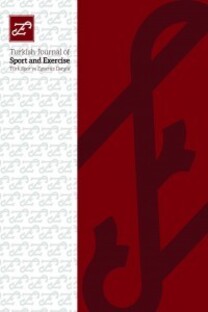Evaluation of different variables of agression levels of physical education and sports school and educational faculty students
Evaluation of different variables of agression levels of physical education and sports school and educational faculty students
___
- Acet M. Sporda saldırganlık ve şiddet, İstanbul: Morpa Kültür Yayınları Ltd. Şti.2005.
- Arkonaç SA. Psikoloji zihin süreçleri bilimi. (2. Basım). İstanbul: Alfa Basım Yayım.1998.
- Balcıoğlu İ. Şiddet ve Toplum. (1. Basım). İstanbul: Bilge Yayıncılık.2001.
- Buss AH, Perry MP. The aggression questionnaire. Journal of Personality and Social Psychology, 1992: 63, 452-459.
- Can S. “Aggression questionnare” adlı ölçeğin Türk popülasyonunda geçerlilik ve güvenilirlik çalışması. Yayınlanmamış uzmanlık tezi, Genel Kurmay Başkanlığı Gülhane Askeri Tıp Akademisi Haydarpaşa Eğitim Hastanesi Ruh Sağlığı ve Hastalıkları Servis Şefliği. 2002.
- Cüceloğlu D. İçimizdeki Çocuk. (1. Basım). Ankara: Remzi Kitabevi.1992.
- Dervent F. Lise öğrencilerinin saldırganlık düzeyleri ve sportif aktivitelere katılımla ilişkisi. Yayımlanmamış Yüksek Lisans Tezi, Gazi Üniversitesi Eğitim Bilimleri Enstitüsü, Ankara.2007.
- Dökmen Ü. Yaşama yerleşmek; küçük şeyler 3. (5. Basım). Ankara: Remzi Kitabevi. 2007.
- Durak N. Son çocukluk dönemi öğrencilerinin saldırganlıklarını belirlemeye yönelik sosyal uyum düzeyinin çeşitli değişkenler açısından incelenmesi. Yayımlanmamış Yüksek Lisans Tezi, Niğde Üniversitesi Sosyal Bilimler Enstitüsü, Niğde.2006.
- Erkal M, Güven Ö, Ayan D. Sosyolojik Açıdan Spor. (3. Basım). İstanbul: Der Yayınları.1998.
- Geçtan E.Psikanaliz ve sonrası. İstanbul: Remzi Kitabevi.1993.
- Giles J, Heyman GD. Young Children’s Beliefs About The Relationship Between Gender and Aggressive Behavior. Child Development. January/February. 2008: 76,1;107 –12.
- İkizler HC, Karagözoğlu C. Sporda Başarının Psikolojisi. İstanbul: Alfa Basım Yayım Dağıtım.1997.
- Karasar N. “Bilimsel Araştırma Yöntemleri”. Ankara: Nobel Yayın.2006.
- Köknel Ö. Kişilik: Kaygıdan Mutluluğa. (13. Basım). İstanbul: Altın Kitaplar Yayınevi.1995.
- Köknel Ö. Bireysel ve Toplumsal Şiddet. (2. Basım). İstanbul: Altın Kitaplar Yayınevi. 2000.
- Köksal F. Denetim odağı ile saldırgan davranışlar arasındaki ilişkiler. Yayımlanmamış Doktora Tezi, Atatürk Üniversitesi Sosyal Bilimler Enstitüsü, Erzurum.1991.
- Kula E. Endüstri Meslek Lisesi Öğrencilerinin Umutsuzluk Düzeyleri ve Saldırganlık Durumları Arasındaki İlişkini İncelenmesi, Yüksek Lisans Tezi, Yeditepe Üniversitesi, Sosyal Bilimler Enstitüsü, Eğitim Yönetimi ve Denetimi Anabilim Dalı, İstanbul. 2008.
- Pulur A. Sporda şiddet ve saldırganlık. Türkiye Üniversite Sporları Dergisi,2001:1,18.
- Scharf SC. Gender differences in adolescent aggression: an analysis of instrumentality expressivenes. Doctoral Thesis. Michigan University Departmant Of Clinical Psychology. Michigan.2000.
- Solak N. Spor yapan ve yapmayan ortaöğretim öğrencilerinin saldırganlık düzeyleri ile empatik eğilim düzeyleri arasındaki ilişkinin incelenmesi. Çorum ili örneği. Yayımlanmış yüksek lisans tezi, Gazi Üniversitesi, Ankara.2011.
- Şahin MH. Sporda şiddet ve saldırganlık. Ankara: Nobel Yayın Dağıtım.2003.
- Tiryaki Ş. Spor Psikolojisi: Kavramlar, Kuramlar ve Uygulama. Ankara:Eylül Kitap ve Yayınevi.2000.
- Tiryaki Ş. Spor Yapan Bireylerin Saldırganlık Düzeylerinin Belirlenmesi:(Takım ve Bireysel Sporlar Açısından Bir
- İnceleme). Mersin Üniversitesi, Sağlık Bilimleri Enstitüsü/Beden Eğitimi ve Spor Anabilim Dalı Yüksek Lisans Tezi. Mersin.1996.
- Var L. Futbol seyircilerinin spor alanlarındaki saldırganlık davranışları hakkında betimsel bir çalışma. Yayımlanmamış Yüksek Lisans Tezi, Gazi Üniversitesi Eğitim Bilimleri Enstitüsü, Ankara.2008.
- Yetim A. Sosyoloji ve spor. İstanbul: Morpa Kültür Yayınları. 2005.
- Yıldız S. Spor Yapan ve Spor Yapmayan Ortaöğretim Öğrencilerinin Saldırganlık Düzeylerinin İncelenmesi. Yüksek lisans tezi, Selçuk Üniversitesi, Konya.2009.
- Yurttaş H. Spor Yapan ve Yapmayan Üniversite Öğrencilerinin Saldırganlık Düzeylerinin İncelenmesi. Yüksek lisans tezi, Atatürk Üniversitesi, Erzurum.2016.
- Yayın Aralığı: 3
- Başlangıç: 1999
- Yayıncı: Selçuk Üniversitesi, Spor Bilimleri Fakültesi
Investıgatıon of the expectatıons from sports and sports centers for dıfferent varıables
Ferhat ÜSTÜN, Erdal TASGIN, Metin ÖZLÜ, Nazlı Deniz ÖZ
Necmi GÜRSAKAL, Fırat Melih YILMAZ, Halil Orbay ÇOBANOĞLU, Sandy ÇAĞLIYOR
Examination of football players’ perfectionism features and subjective stress perceptions
Ziya BAHADIR, Ramazan TOPUZ, Çağrı Hamdi ERDOĞAN
Burak CANPOLAT, Mehmet ILKIM, Betül AKYOL
Tolga ESKİ, Ayşe Feray ÖZBAL, Arıkan EKTİRİCİ
Comparison of gross motor development of 3-7 years old children in different geographical regions
